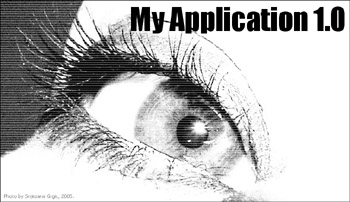Creating Splash Screens
A splash screen is a form that is displayed at application startup, typically while the application is busy creating other forms. The splash screen usually displays the company's name and logo and the application's name and version.
From a technical point of view, a splash screen is totally unnecessary in small applications because they often load very quickly. Splash screens are used in more complex applications to distract the user from counting the seconds (yeah, right) it takes for an application to load.
The first thing you have to do is add a new form to the project, name it SplashForm, and remove it from the auto-create list.
Splash forms are usually borderless and positioned in the center of the screen. So, set the BorderStyle property to bsNone and the Position property to poScreenCenter.
Now, open the main project file and dynamically create the SplashForm form. See Listing 12-21A for the Delphi version and Listing 12-21B for the C++ version. To use the SplashForm form in the main project file, don't forget to #include the form's header file.
Listing 12-21A: Creating the splash form
program Project1; uses Forms, Unit1 in 'Unit1.pas' {Form1}, Unit2 in 'Unit2.pas' {SplashForm}; {$R *.res} begin Application.Initialize; { Create & display the splash screen } SplashForm := TSplashForm.Create(Application); SplashForm.Show; SplashForm.Update; Application.CreateForm(TForm1, Form1); { Destroy the splash screen } SplashForm.Free; Application.Run; end. Listing 12-21B: Creating the splash form, C++ version
#include <vcl.h> #include <windows.h> #pragma hdrstop #include "Unit2.h" // SplashForm USEFORM("Unit1.cpp", Form1); USEFORM("Unit2.cpp", SplashForm); WINAPI WinMain(HINSTANCE, HINSTANCE, LPSTR, int) { try { Application->Initialize(); SplashForm = new TSplashForm(Application); SplashForm->Show(); SplashForm->Update(); Application->CreateForm(__classid(TForm1), &Form1); delete SplashForm; Application->Run(); } catch (Exception &exception) { Application->ShowException(&exception); } catch (...) { try { throw Exception(""); } catch (Exception &exception) { Application->ShowException(&exception); } } return 0; } As you can see, the splash screen is a modeless form. If you display the splash screen as a modal form, the application will not run until you close it. The splash screen is displayed with two methods: Show and Update. The Update method actually displays the form in this case — it forces the form to display itself.
Since this example only creates the main form automatically, the splash screen will only be displayed for a short time. To see the splash screen a bit longer, you have to pause the application for a second or two by calling the Sleep procedure. The Sleep procedure is declared in the Windows unit (or windows.h if you're using C++Builder) and accepts a single integer value: the number of milliseconds the application should remain inactive. You should call the Sleep procedure before you release the splash screen.
Listing 12-22: Displaying the splash screen
program Project1; uses { The Sleep procedure is declared in the Windows unit } Forms, Windows, Unit1 in 'Unit1.pas' {Form1}, Unit2 in 'Unit2.pas' {SplashForm}; {$R *.res} begin Application.Initialize; { Create & display the splash screen } SplashForm := TSplashForm.Create(Application); SplashForm.Show; SplashForm.Update; Application.CreateForm(TForm1, Form1); { Destroy the splash screen, but first wait 2 seconds. } Sleep(2000); SplashForm.Free; Application.Run; end. 
Figure 12-23: A splash screen
EAN: 2147483647
Pages: 212
- The Second Wave ERP Market: An Australian Viewpoint
- Enterprise Application Integration: New Solutions for a Solved Problem or a Challenging Research Field?
- Intrinsic and Contextual Data Quality: The Effect of Media and Personal Involvement
- Healthcare Information: From Administrative to Practice Databases
- A Hybrid Clustering Technique to Improve Patient Data Quality